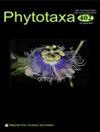蟛蜞菊(菊科,Heliantheae)的分类研究揭示了巴西塞拉多地区的一个新物种
IF 1
4区 生物学
Q3 PLANT SCIENCES
引用次数: 0
摘要
蟛蜞菊(Wedelia)是菊科蟛蜞菊属(Heliantheae,Asteraceae)中最大的一个属,约有 110 个种。巴西的塞拉多(Cerrado)是一个受到高度威胁的植物地理区域,在世界其他热带稀树草原中拥有最丰富的植物群。tenuinervia。foliacea 相似,但其主要区别在于叶片有帚状脉纹、雌蕊射线花、叶片背面有腺毛、花冠裂片和顶端花药附属物、叶片背面具短糙伏毛,花盘苞片呈 4-5 角形,在角上呈龙骨状,无基部疤痕或elaiosomes,瓣基不明显(vs.腋生脉序,中性射线花,叶片背面、花冠裂片和顶端花药附属物缺乏腺毛,叶片背面具刚毛或后脱落,花盘辐状聚伞花序双凸面,不具龙骨状棱角,有基部痕或elaiosomes,瓣基为两片或一片浅裂)。在具有雌蕊射线花的物种中,W. tenuinervia 与 W. oligocephala 在形态上有亲缘关系,主要区别在于膜质叶片边缘平整,具帚状脉纹和单生头状花序(而二歧叶近角质叶片边缘外卷,具刺状脉纹和头状花序)。提出了 W. foliacea 的异名的插图、评论、初步保护状况和类型。本文章由计算机程序翻译,如有差异,请以英文原文为准。
Taxonomic studies in Wedelia (Asteraceae, Heliantheae) reveal a new species for the Brazilian Cerrado
Wedelia is the largest genus of Ecliptinae (Heliantheae, Asteraceae), comprising about 110 species. The Brazilian Cerrado is a highly threatened phytogeographic domain, which harbors the richest flora in the world among other savannas. A new subshrubby species of Wedelia was revealed occurring in the central part of Cerrado and is herein described as W. tenuinervia. This new species resembles W. foliacea in vegetative traits but differs mainly by having leaves with brochidodromous venation, pistillate ray flowers, glandular trichomes on the abaxial surface of the leaf blade, corolla lobes and apical anther appendages, phyllaries abaxial surface strigillose and disc cypselae 4–5-angled, keeled at the angles, without basal scars or elaiosomes, and carpopodium inconspicuous (vs. acrodromous venation, neuter ray flower, abaxial surface of the leaf blade, corolla lobes and apical anther appendage lacking glandular trichomes, phyllaries abaxial surface setose or glabrescent, and disc cypselae biconvex, not keeled, with basal scars or elaiosomes, and carpopodium in two plates or one shallowly lobed). Among the species with pistillate ray flowers, W. tenuinervia can be morphologically related to W. oligocephala, differing mainly by the membranaceous leaf blades with flat margins, brochidodromous venation, and solitary capitula (vs. subcoriaceous leaf blades with revolute margins, acrodromous venation and capitula in dichasia). Illustrations, comments, a preliminary conservation status, and the typification of W. foliacea’s synonyms are proposed.
求助全文
通过发布文献求助,成功后即可免费获取论文全文。
去求助
来源期刊

Phytotaxa
PLANT SCIENCES-
CiteScore
1.90
自引率
27.30%
发文量
956
审稿时长
1 months
期刊介绍:
Phytotaxa is a peer-reviewed, international journal for rapid publication of high quality papers on any aspect of systematic and taxonomic botany, with a preference for large taxonomic works such as monographs, floras, revisions and evolutionary studies and descriptions of new taxa. Phytotaxa covers all groups covered by the International Code of Nomenclature foralgae, fungi, and plants ICNafp (fungi, lichens, algae, diatoms, mosses, liverworts, hornworts, and vascular plants), both living and fossil. Phytotaxa was founded in 2009 as botanical sister journal to Zootaxa. It has a large editorial board, who are running this journal on a voluntary basis, and it is published by Magnolia Press (Auckland , New Zealand). It is also indexed by SCIE, JCR and Biosis.
All types of taxonomic, floristic and phytogeographic papers are considered, including theoretical papers and methodology, systematics and phylogeny, monographs, revisions and reviews, catalogues, biographies and bibliographies, history of botanical explorations, identification guides, floras, analyses of characters, phylogenetic studies and phytogeography, descriptions of taxa, typification and nomenclatural papers. Monographs and other long manuscripts (of 60 printed pages or more) can be published as books, which will receive an ISBN number as well as being part of the Phytotaxa series.
 求助内容:
求助内容: 应助结果提醒方式:
应助结果提醒方式:


